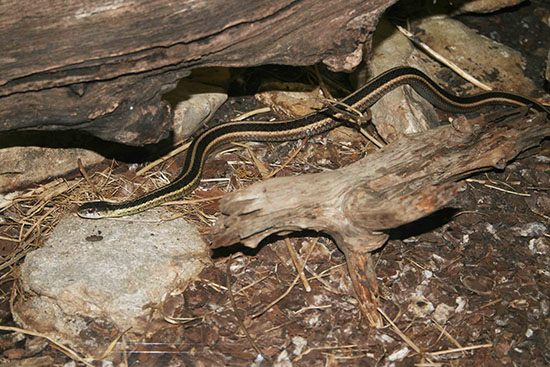Issue 3, May 15, 2017
Snakes
Few people like snakes. We might admire them begrudgingly, usually behind an inch-thick piece of glass or Plexiglas. We might attempt to stroke our hands across the snakes back that someone is holding, feeling the coldness to the scales.
The most common snake is the garter snake, and really one of the best creatures you could have in a landscape. Most snake lovers will tell you that it is moving in the opposite direction, albeit with less speed, than you are when you encounter one unsuspectingly.

Eastern garter snake.
Garter snakes, one of the many non-poisonous snakes in Illinois, are an interesting phenomenon in the snake world for a variety of reasons. First, garter snakes are one of the few snakes that don't lay eggs. They give birth to living young. The young snakes leave their mother as soon as they're born to forage on their own. She has no way of nursing or feeding them.
A female can give birth up to 50 or 80 little ones a year, spread out over the course of several months; she has the ability to store sperm until she needs it. Most of the little ones are about 6 to 10 inches in length when born. When fully grown, a garter snake can reach more than 3 feet and live for 3 to 10 years.
Garter snakes feed on a wide range of creatures from grasshoppers, crickets and katydids to bird eggs, small birds, field mice and voles. Ground squirrels and moles are probably too big, but if they run across a nest of babies, it's not impossible for the snake to have a dinner.
Some garter snakes will climb a small tree or shrub which can be disconcerting the first hundred times you see one slithering down a low lying limb. A few will even go in the water and feed on fish.
The reptiles are also cold blooded, meaning they love to sun themselves for warmth. That's why you find them on top of mulch, a rock, crawling across the sidewalk or driveway, or in the middle of a mowed lawn. In warm weather, they're active during the day, hiding at night. Come fall and winter, they tend to search for some type of hole or make one themselves, and nest there, occasionally popping out on warm days.
Most snakes are solitary creatures, except for the winter when you can find 7 to 10 in a group, each providing some warmth to the others. In areas farther north such as Minnesota, garter snakes winter together in the hundreds.
Garter snakes are docile and you can pick them up. However, they may secrete a foul smelling yellow liquid from their anal glands. And to confuse the average person even more, these glands are located about three-fourths the way back from the head. The last quarter is the snake's tail.
Garter snakes are usually dark with one to three yellow stripes running from head to tail. The Chicago type, which could be its own species or subspecies of the common garter depending on which taxonomist you talk to, has some red on the body. It's found mainly in the northeast part of the state. The body of mature snakes is dark brown to black in color, and covered with overlapping scales.
Snakes don't move fast, but will usually be moving in the opposite direction as you or any other predators, such dogs, cats, coyotes, skunks or weasels. They also can be preyed upon by owls and hawks. They'll slide under leaf litter or thick mulch to hide.
To avoid encountering snakes, stomp your feet before entering a landscape bed or other area likely to have snakes. The snakes feel the vibrations and move away from you.
Ideally, you don't want to get rid of any snake. If they startle you, or if you're overly concerned, take a shovel or rake handle and move the snake into a bucket or sack, and then take the snake to a natural area.
To reduce the number of snakes, reduce habitat for them and their prey. Don't mulch. Keep the grass mowed. Avoid large rocks or boulders in the landscape. Keep vegetation to a minimum around buildings. (David Robson)
Author:
David Robson